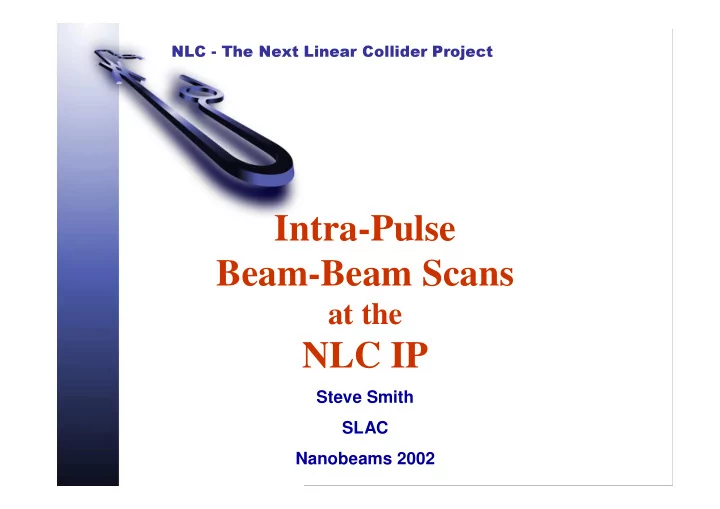

����� �������������������������������� Intra-Pulse Beam-Beam Scans at the NLC IP Steve Smith SLAC Nanobeams 2002
Beam-Beam Scans Next Linear Collider Next Linear Collider • Important linear collider diagnostic – Spots sizes – Alignment – Waists – Etc. etc. etc… • Some Limitations: – Takes lots of time at one measurement per pulse train – Sensitive to drifts over length of scan • i.e . low frequency noise, drift • Pulse-pulse jitter • Can we do a scan in one bunch train? – Increase utility of diagnostic by increasing speed – Reduce sensitivity to drift and low frequency noise • Yes – Assuming existence of intra-pulse IP feedback. $XWKRU�1DPH Date Steve Smith Nanobeams 2002 Slide #
Beam-Beam Deflection Next Linear Collider Next Linear Collider A. Seryi $XWKRU�1DPH Date Steve Smith Nanobeams 2002 Slide #
Intra-Pulse Feedback Next Linear Collider Next Linear Collider Kicker Amp Amp IP Round + Trip Delay BPM Processor BPM $XWKRU�1DPH Date Steve Smith Nanobeams 2002 Slide #
Intra-pulse Feedback Next Linear Collider Next Linear Collider • Fix IP jitter within the crossing time of a bunch train (250 ns) • BPM measures beam-beam deflection on outgoing beam – Fast (few ns rise time) – Precise (~micron resolution) – Close (~4 meters from IP?) • Kicker steers incoming beam – Close to IP (~4 meters) – Close to BPM (minimal cable delay) – Fast rise-time amplifier • Feedback algorithm to converge within bunch train. $XWKRU�1DPH Date Steve Smith Nanobeams 2002 Slide #
Single-Pulse Beam-Beam Scan Next Linear Collider Next Linear Collider • Fast BPM and kicker needed for interaction point stabilization • Open the loop and program kicker to sweep beam • Digitize fast BPM analog output • Acquire beam-beam deflection curve in a single machine pulse • Eliminates inter-pulse jitter from the beam-beam scan. • Use to • Establish collisions • Measure IP spot size • Waist scans. • What else? $XWKRU�1DPH Date Steve Smith Nanobeams 2002 Slide #
Intra-Pulse Feedback Next Linear Collider Next Linear Collider (with Beam-Beam Scan & Diagnostics) r e k c i K Amp Amp IP Round + Trip Delay BPM Processor Beam-Beam Scan & Diagnostics B Ramp P M Digitizer $XWKRU�1DPH Date Steve Smith Nanobeams 2002 Slide #
Beam-Beam Scan Next Linear Collider Next Linear Collider Beam bunches at IP: blue points $XWKRU�1DPH BPM analog response: green line Date Steve Smith Nanobeams 2002 Slide #
Single Pulse Beam Scans Next Linear Collider Next Linear Collider • How much information in a scan? – Potentially 180 points per scan! – Feedback system needs 100 - 200 MHz bandwidth. – Can get possibly 50 to 100 nearly independent measurements in a pulse. – Depending on resolution required. • Invasive/Non-invasive – Invasive for range > luminosity height – Non-invasive range < luminosity height (Beam dithering) • Could operate concurrently with IP feedback closed loop – If you know the transfer function well enough. $XWKRU�1DPH Date Steve Smith Nanobeams 2002 Slide #
Conclusions Next Linear Collider Next Linear Collider • Given Intra-Pulse Interaction Point Feedback, we have tools to perform beam-beam scans within the bunch train. • Speeds up beam-beam scans by an order of magnitude or more. • Optimize more parameters more often. • Reduces low frequency noise in beam-beam scans – Machine drifts – Pulse-pulse jitter – 1/f noise • Valuable • Nearly free! $XWKRU�1DPH Date Steve Smith Nanobeams 2002 Slide #
Recommend
More recommend